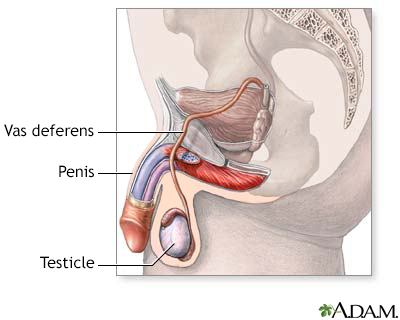Pregnancy SmartSiteTM
Vanishing testes - anorchia; Empty scrotum - anorchia; Scrotum - empty (anorchia) DefinitionAnorchia is the absence of both testes at birth. CausesThe embryo develops early sex organs in the first several weeks of pregnancy. In some cases, early testes do not develop in males before 8 weeks into the pregnancy. These babies will be born with female sex organs. In some cases, the testes disappear between 8 and 10 weeks. These babies will be born with ambiguous genitalia. This means the child will have parts of both male and female sex organs. In some cases, the testes may disappear between 12 and 14 weeks. These babies will have normal penis and scrotum. However, they will not have any testes. This is known as congenital anorchia. It is also called the "vanishing testes syndrome." The cause is unknown. Genetic factors may be involved in some cases. This condition should not be confused with bilateral undescended testes, in which the testes are located in the abdomen or groin rather than the scrotum. SymptomsSymptoms may include:
Exams and TestsSigns include:
Tests include:
TreatmentTreatment includes:
Outlook (Prognosis)The outlook is good with treatment. Possible ComplicationsComplications include:
When to Contact a Medical ProfessionalContact your health care provider if a male child:
ReferencesAli O, Donohoue PA. Hypofunction of the testes. In: Kliegman RM, St. Geme JW, Blum NJ, Shah SS, Tasker RC, Wilson KM, eds. Nelson Textbook of Pediatrics. 21st ed. Philadelphia, PA: Elsevier; 2020:chap 601. Chan Y-M, Hannema SE, Achermann JC, Hughes IA. Disorders of sex development. In: Melmed S, Auchus RJ, Goldfine AB, Koenig RJ, Rosen CJ, eds. Williams Textbook of Endocrinology. 14th ed. Philadelphia, PA: Elsevier; 2020:chap 24. Yu RN, Diamond DA. Disorders of sexual development: etiology, evaluation, and medical management. In: Partin AW, Dmochowski RR, Kavoussi LR, Peters CA, eds. Campbell-Walsh-Wein Urology. 12th ed. Philadelphia, PA: Elsevier; 2021:chap 48. | |
| |
Review Date: 7/4/2022 Reviewed By: Kelly L. Stratton, MD, FACS, Associate Professor, Department of Urology, University of Oklahoma Health Sciences Center, Oklahoma City, OK. Also reviewed by David C. Dugdale, MD, Medical Director, Brenda Conaway, Editorial Director, and the A.D.A.M. Editorial team. The information provided herein should not be used during any medical emergency or for the diagnosis or treatment of any medical condition. A licensed medical professional should be consulted for diagnosis and treatment of any and all medical conditions. Links to other sites are provided for information only -- they do not constitute endorsements of those other sites. No warranty of any kind, either expressed or implied, is made as to the accuracy, reliability, timeliness, or correctness of any translations made by a third-party service of the information provided herein into any other language. © 1997- A.D.A.M., a business unit of Ebix, Inc. Any duplication or distribution of the information contained herein is strictly prohibited. | |

 Male reproductive ...
Male reproductive ... Male reproductive ...
Male reproductive ...
